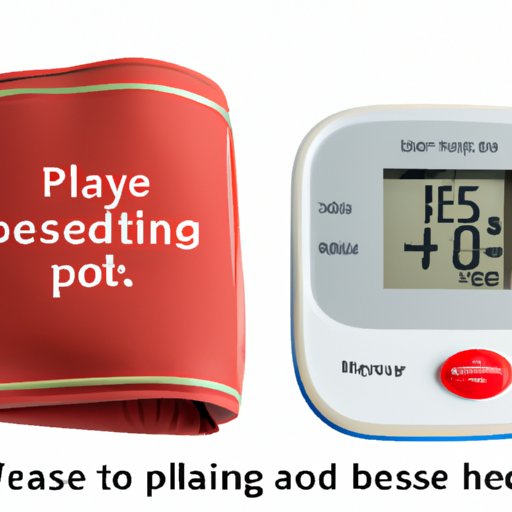
I. Introduction
Diastolic blood pressure refers to the pressure in your arteries when your heart is at rest between beats. It is an important indicator of overall cardiovascular health and plays a critical role in preventing heart disease, stroke, and other serious health issues. Maintaining healthy diastolic blood pressure levels is essential for optimal health and longevity. This article will provide helpful tips and strategies for lowering diastolic blood pressure through lifestyle changes, diet, exercise, stress management, and other proven techniques.
II. The Impact of Diet on Diastolic Blood Pressure
A well-balanced diet that is rich in certain nutrients can play a critical role in lowering diastolic blood pressure levels. Key nutrients that have been shown to be effective in reducing blood pressure include potassium, magnesium, and fiber. These nutrients help to reduce inflammation, improve blood flow, and support healthy circulation. Foods rich in these nutrients include:
- Bananas, oranges, avocados, and potatoes (high in potassium)
- Spinach, almonds, cashews, and whole grains (high in magnesium)
- Fresh fruits, vegetables, and legumes (high in fiber)
Incorporating more of these foods into your diet can help to lower diastolic blood pressure levels. You can also try reducing your intake of sodium, processed foods, and sugary drinks, which can contribute to high blood pressure.
III. The Importance of Exercise in Maintaining a Healthy Diastolic Blood Pressure
Regular physical activity can also play a significant role in lowering diastolic blood pressure levels. Exercise helps to improve circulation, strengthen the heart muscle, and reduce inflammation throughout the body. Some effective types of exercise for reducing diastolic blood pressure include:
- Aerobic exercise, such as brisk walking, cycling or swimming
- Strength training, using weights or resistance bands
- Yoga, which can help to reduce stress and improve circulation
It’s important to aim for at least 30 minutes of moderate exercise most days of the week. If you’re new to exercise, start slowly and gradually increase your activity level over time. You can also try finding an exercise buddy or joining a group class to help keep you motivated and accountable.
IV. The Role of Stress Management Techniques in Reducing Diastolic Blood Pressure
The relationship between stress and blood pressure is well-established. Chronic stress can significantly raise blood pressure levels, making it a critical factor in managing diastolic blood pressure. There are several effective stress management techniques that can help to lower blood pressure, including:
- Meditation and mindfulness practices
- Yoga and deep breathing exercises
- Aromatherapy and massage therapy
These techniques work by signaling the body’s relaxation response, which helps to reduce tension, lower heart rate, and decrease blood pressure levels. Incorporating these practices into your everyday routine can help to reduce stress and promote overall health and wellbeing.
V. The Benefits of Maintaining a Healthy Weight for Managing Diastolic Blood Pressure
Excess weight is a significant risk factor for high blood pressure and other serious health conditions. Losing weight and maintaining a healthy weight can significantly lower diastolic blood pressure levels, reduce inflammation, and improve overall cardiovascular health. Some tips for achieving and maintaining a healthy weight include:
- Eating a well-balanced diet that includes plenty of fresh fruits, vegetables, and whole grains
- Incorporating regular physical activity into your routine
- Tracking your food intake and exercise with a journal or app
- Getting enough sleep and managing stress levels
By making sustainable lifestyle changes, you can achieve a healthy weight, lower your diastolic blood pressure levels, and reduce your risk of developing serious health conditions like heart disease and stroke.
VI. Medications and Treatments for Lowering Diastolic Blood Pressure
While lifestyle changes are usually the first line of defense against high blood pressure, there are several medications and treatments available that can help to lower diastolic blood pressure levels. Some commonly prescribed medications include:
- Diuretics, which help to remove excess fluids and salts from the body
- Calcium channel blockers, which help to relax blood vessels and improve blood flow
- Beta-blockers, which help to reduce the workload of the heart
There are also several natural remedies and alternative treatments that can be effective for managing diastolic blood pressure, such as:
- Hawthorn, an herbal remedy that has been shown to help lower blood pressure levels
- Acupuncture, which can help to stimulate relaxation and improve circulation
- Chiropractic adjustments, which can help to reduce tension and improve body alignment
Your healthcare provider can help you determine which treatment options are best suited for your individual needs and health goals.
VII. Conclusion
While high blood pressure can be a serious health concern, there are many effective techniques and strategies available for lowering diastolic blood pressure levels naturally. By incorporating healthy lifestyle habits like a well-balanced diet, regular exercise, stress management, and maintaining a healthy weight, you can significantly improve your cardiovascular health and reduce your risk of serious health issues. By working closely with your healthcare provider, you can develop a personalized treatment plan that meets your individual needs and goals.




